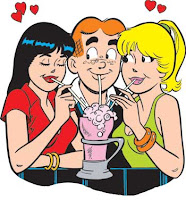Women in the Company of Women
While we stopped for a midday pizza break during our Saturday rehearsal, our dramaturg Richard Horwich shared some insightful text
analysis with the cast. He illuminated certain interconnected themes within the
play that inspired various elements of our production...
 |
| Kathryn Lerner and Kasia Klimiuk (Center) playing Lysander and Demetrius respectively, are two of the seven females playing male roles in HIT Fest's production of Midsummer. |
...most notably some gender-bending casting decisions...
In many of his comedies, Shakespeare uses the comic device
of a green world as a vehicle to expound upon subversive ideas that mock or
criticize the social order imposed by Elizabethan society. So it goes
with Midsummer, where--it could be argued--in seeming celebration of heterosexual love, Shakespeare
none-too-subtly criticizes the institution of marriage.
There
are various all-female societies alluded to within “A Midsummer Night’s Dream,”
which Shakespeare presents as alternative
options to marriage for young women.
There is the society of Amazons of which the conquered Hippolyta is queen,
There is the convent where Hermia is told she must live forever in chastity if she refuses to marry according to her father’s wishes,
 |
| Titania and the Changeling Child, John Anster Fitzgerald (1832- 1906) |
There
are the votaresses of Titania’s order (one of whom births the Changeling Boy),
And there
is the society of young girls described by Helena in her speech about her
schooldays friendship with Hermia.
It
could be argued that all of these instances of female platonic love are thrown
into discord by the interference of men,
Through
love or violence, or oftentimes: violent love.
“Hippolyta, I wooed thee with my sword
And won thy love doing thee injuries.”
... Ok, no, this is not Theseus.
The battle of the sexes, personified by the soon-to-be-wed
war enemies Theseus and Hippolyta, is also reflected by the quarrel in the
fairy kingdom between Oberon and Titania: a “custody dispute” over a changeling
boy that has set the entire natural world out of balance.
 |
| The Quarrel of Oberon and Titania - Sir Joseph Noel Patton, circa 1849 |
Titania’s
vow to raise the changeling boy is symbolic of her loving relationship to her
votaress, who died in childbirth. Her unwillingness to surrender to Oberon’s
will and give the boy up draws a strong parallel to Hippolyta’s (likely)
reluctance to abandon the company of women and wed Theseus.
“I
have forsworn his bed and company,” Titania says of Oberon at the top of Act 2
...Is this Theseus’ fear as well?
Oberon resorts to trickery to
win the boy from Titania. As she sleeps, he anoints her eyes with the juice of
a magical flower that puts her under a spell of lovesickness, causing her to
fall madly in love with the first creature she sees upon waking.
...This guy.
The flower is called Love-in-Idleness, and its magical
properties account for the greatest comic device of the play. In Roman
mythology, this white pansy is struck by cupid’s arrow (Cupid has, notably,
missed his intended target), causing it to turn a deep purple color and
endowing it with its supernatural power.
Throughout
the play, falling in love is likened to catching sickness, a comparison that highlights the irrational, arbitrary nature of attraction. This “Love-in-Idleness”
seems as much an affliction as a spell-- once caught, it causes a sort of blind
madness which the four Athenian lovers try in vain to reason away with words and logic.
Is
the flower really a flower? Or is love-in-idleness merely a dreamy apology for
the fickleness of young love-- the inevitable affliction of the unmarried?
After all, the hate, jealousy and anger that grows between the four during their midnight romp in the woods is not caused by the fairies’
magic, merely redistributed.
Although
the play is chock full of the lofty florid language of lovers, the weight of these declarations of idolatrous affection is undercut by a deeper
thematic current of cynicism regarding coupling and marriage.
The
perversity of heterosexual love is examined time and again—just as the Duke
plans to wed an enemy of war and the proud fairy queen madly dotes on an ugly
beast, so too the lovesick Helena begs to be beaten like a dog, and Demetrius
pursues an openly scornful Hermia.
Perhaps
this is why, during what is likely the lovers’ most famous scene (3.2), the loss of the platonic love between Helena and Hermia seems far more tragic than the confusion of the romantic love between the sexes.
And perhaps
it is only in this dream world of the forest that the society of women can retain its place in adult life. For once Helena and Hermia leave the woods they are
married, and silenced by Shakespeare for the remainder of the play—neither
breathes a word through the entirety of the fifth act.
But
just as Shakespeare often eludes the rules and structures of society with his
green worlds and meta-theatrical devices, so shall we players of HIT Fest do
with this summer’s al fresco production...
In
Midsummer performances of Shakespeare’s age, all-male troupes of actors would likely have presented this play following a wedding ceremony. In those productions, Jack
would have Jill, who was really another Jack in Jill’s clothing.
We
will begin and end our story with the green world underfoot-- and Jack, who is
really Jill, shall have another Jill. Nought shall go ill, the [wo]man shall
have her mare again, and all shall be well.
















Did I say all those things? Not as well as you said them.
ReplyDelete